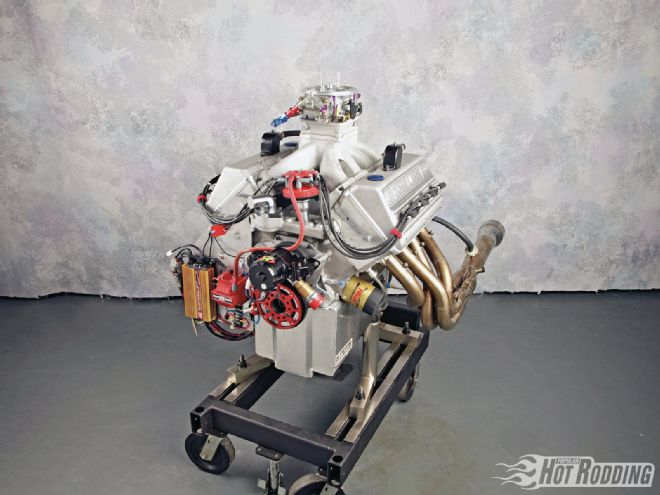
When it comes to building custom performance engines, there are numerous choices in terms of what direction to take. For many, improving the OEM design theme is accomplishment enough, using replacement-style parts that offer to significantly improve output. For the likes of Nick Arias Jr., getting the most from an engine means starting with a clean sheet of paper, and then making the parts in accordance to his uncompromising all-out performance ways. As Arias likes to put it, “You can make a great street engine from a race engine, but you can’t make a great race engine from a street engine.” A case in point is the 427-cube Ford featured here. Using a hemispherical cylinder head conversion developed by Arias, the engine is capable of phenomenal output in a race configuration, while the same basic package can be built for reliable street duty with outstanding performance.
In the creation of the specialty hemispherical head conversion for Ford’s Windsor small-block, several factors came together that brought the idea into development. Arias clearly had the manufacturing know-how and the track record to make it happen, with Arias’ Hemi conversions for the Chevy big-block having achieved legendary status since its introduction in 1972. Among numerous other accomplishments and specialty engines, Arias also brought the world the incredible Arias 10.0-liter, a full custom engine design using hemi heads that saw dominance in tractor pulling and drag boats. The link to the Shelby name came via engine builder Lanny Trefz, a good friend of Arias’ who was also well acquainted with Bob Denbeste, of Denbeste Motorsports. Denbeste’s passion, beyond having an impressive collection of Shelby automobiles, is building licensed replicas of Carroll Shelby’s classics. Denbeste also acquired Carroll Shelby Engine Company, building and selling classic Ford engines and performance parts, specializing in engines for Shelby applications. The Arias/Shelby package was conceived as a unique high-powered package that would be right at home in one of these exotic vehicles.
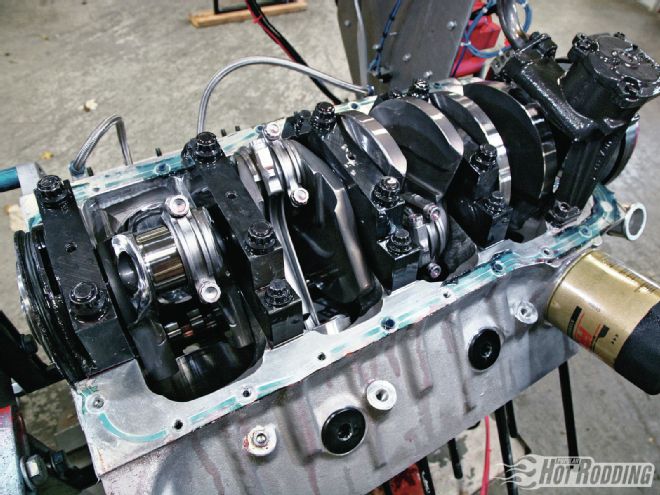 If you are building an engine with a top end combination capable of extreme horsepower, the bottom end had better be up to the challenge. LTR’s Arias/Shelby Ford Hemi combination was built on a Shelby aluminum 9.5-inch deck Windsor block, featuring massive steel main caps and ARP studs. A Scat billet crank and 6.250-inch Carrillo rods ensure the bottom-bottom end stays together.
If you are building an engine with a top end combination capable of extreme horsepower, the bottom end had better be up to the challenge. LTR’s Arias/Shelby Ford Hemi combination was built on a Shelby aluminum 9.5-inch deck Windsor block, featuring massive steel main caps and ARP studs. A Scat billet crank and 6.250-inch Carrillo rods ensure the bottom-bottom end stays together.
The Build
To show off the engine combination’s capabilities, the engine featured here was built to compete in our annual engine building competition, the AMSOIL Engine Masters Challenge. Lanny Trefz’s LTR Engines took on the task of the build. Trefz started with a Shelby alloy 9.5-inch deck Windsor block featuring A356 T6 aluminum construction with beefy billet steel mains and centrifugally cast dry sleeves. This high-end block is built to take punishment, while coming in at a weight of only about 90 pounds. The aluminum alloy block is just the item to provide a tremendous power-to-weight ratio in the Shelby vehicles, shaving over 100 pounds compared to a production block, and substantially more compared to the iron aftermarket blocks typically used in high-powered engine builds.
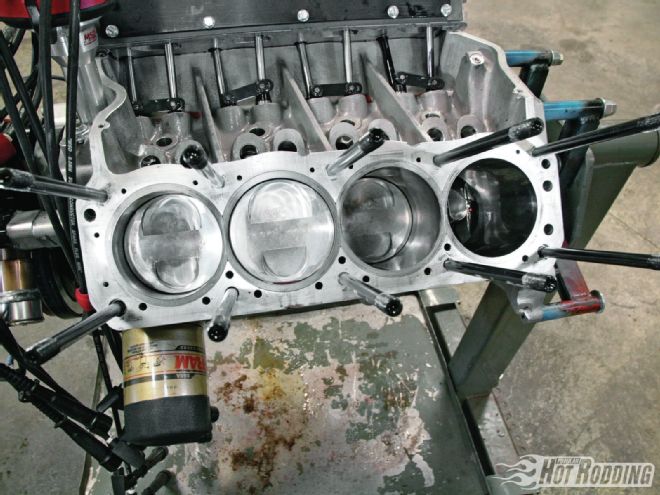 The Shelby Clevor aluminum block features steel dry cylinder sleeves, and the system has proven to be reliable even in extended street use. A special Cometic gasket seals the block’s decks against the Arias/Shelby heads, with ARP studs manufactured to Arias’ specs. Note the rugged ribbed lifter valley of the Shelby aluminum block.
The Shelby Clevor aluminum block features steel dry cylinder sleeves, and the system has proven to be reliable even in extended street use. A special Cometic gasket seals the block’s decks against the Arias/Shelby heads, with ARP studs manufactured to Arias’ specs. Note the rugged ribbed lifter valley of the Shelby aluminum block.
Naturally, you don’t cut corners when building an engine like this, so Trefz filled the bottom end with some of the best components the aftermarket has to offer, starting with a Scat billet steel crank cut for 1.88-inch Honda journals. Trefz explains: “The small journals reduce rotating mass and inertia, and cut friction through the reduced bearing speed. I was basically building a NASCAR-style bottom end.” The aluminum block will expand more than a comparable iron unit, so special consideration is given to the main bearing clearance. Trefz points out: “As the block grows, so does bearing clearance, so the mains are set up tighter than with an iron block. Working out the details of what is appropriate given the material is all part of the build process.”
Attached to the crank are Carrillo rods and gas-ported Arias pistons specific to the top end combination. Trefz had the pistons cut for very narrow-section .8mm compression rings from Total Seal. As Trefz explains, “The narrow ring actually provides more unit loading on the cylinder wall for a very good compression seal. The gas ports supply pressure to the back of the ring, while the surface area is reduced due to the thinner profile.” The combination worked extremely well, with Trefz reporting negligible leakage past the rings when testing leakdown, and a combustion space that was very clean after running.
Capping the cylinders is the crowning jewel of the combination, the Arias/Shelby cylinder heads. Arias started from the ground up in developing these cylinder heads, beginning with flow-box mock-ups to develop the port configuration, and then seeing the design through casting and final machining. The hemispherical port layout features dramatically raised runners, giving a line-of-sight straight shot into and out of the cylinders. As might be expected, airflow is abundant, with the CNC finish-ported versions delivering 409 cfm peak, and over 300 cfm available from the exhaust. Arias used a relatively shallow combination of valve angles, at 15 degrees, intake, and 16 degrees, exhaust. The valve angles allow for a much smaller chamber volume than older Hemi designs—a decided advantage when considering the compression ratio achievable with a flat-top piston. Arias offers the cylinder head in two chamber variations, the full round 74cc hemisphere design used in this engine, or a “Pro Stock” inspired figure eight–shaped version at 67cc with quench pads. The central spark plug location enhances the combustion characteristics.
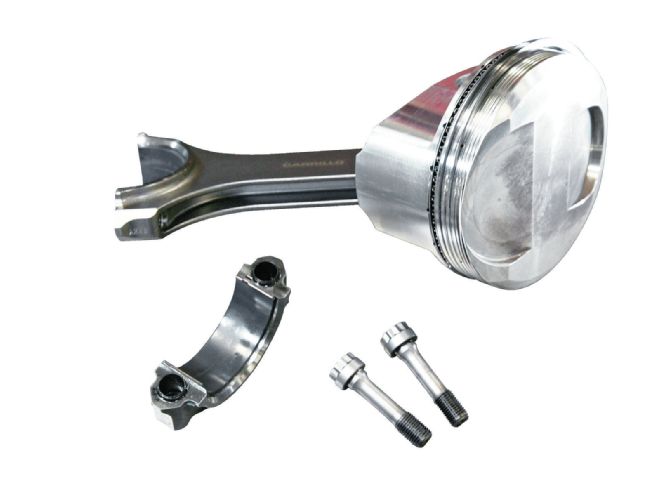 Filling the bores is a set of Arias pistons, which are specific to the Arias/Shelby Hemispherical heads. Note the opposed valve reliefs in the pistons, which are designed for the unique valve layout. Rings are Total Seal, with .8mm by .140-inch compression rings. The bearings are Clevite units, featuring a coating for an extra measure of protection.
Filling the bores is a set of Arias pistons, which are specific to the Arias/Shelby Hemispherical heads. Note the opposed valve reliefs in the pistons, which are designed for the unique valve layout. Rings are Total Seal, with .8mm by .140-inch compression rings. The bearings are Clevite units, featuring a coating for an extra measure of protection.
Trefz expanded upon the performance benefits of the Arias/Shelby head configuration: “The hemi opens to the center of the cylinder. It’s not shrouded like a small-block or big-block Chevy. Sometimes you put a bigger valve in one of those engines, and it makes less power because the valve is crowding the cylinder wall. With the hemi, it’s opening to the middle of the cylinder, and that’s the advantage of the hemi cylinder head—it has to do with airflow. If I could build the perfect flow bench it would have a short-block on it with a piston in the cylinder, and I’d try testing with different piston configurations. It all affects how the air actually flows through an assembled engine.”
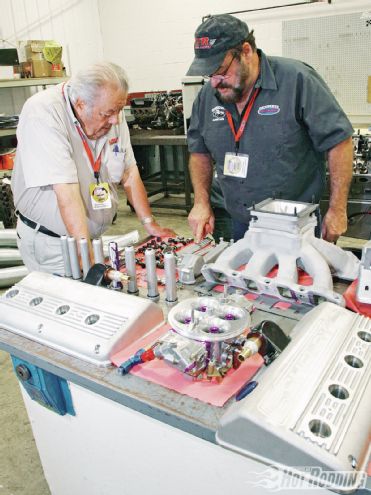 What truly makes this engine package unique is the Arias/Shelby top end package. Arias has decades of experience manufacturing specialty Hemi conversions, and this Windsor Ford setup, as well as a similar LS Chevy version, are the latest developments. Here Nick Arias Jr. (left), along with LTR’s Lenny Trefz, examine the Arias/Shelby Ford during teardown at the 2011 Engine Masters Challenge.
What truly makes this engine package unique is the Arias/Shelby top end package. Arias has decades of experience manufacturing specialty Hemi conversions, and this Windsor Ford setup, as well as a similar LS Chevy version, are the latest developments. Here Nick Arias Jr. (left), along with LTR’s Lenny Trefz, examine the Arias/Shelby Ford during teardown at the 2011 Engine Masters Challenge.
Of the more complex aspects of developing an all-new cylinder head configuration is the rocker arrangement. Here Arias was serious about quality and reliability with investment cast 4340 steel roller-tip rocker arms with dual needle bearings and H-13 lash adjusting screws. The rockers deliver a ratio of 1.82:1, intake, and 1.75 on the exhaust, with the intake and exhaust rockers riding on their own shafts at the opposite extremities of the cylinder heads. From the rockers themselves, to the shafts, supports, and mounting hardware, the engineering and manufacturing quality is second to none. To top the cylinder head, the Arias/Shelby conversion heads are mated to cast-aluminum finned valve covers with breathers, oil fill caps, O-ring seals, spark plug tubes, and hardware—all part of the package. The covers can be had in black wrinkle finish, high-luster polished, carbon fiber, or as-cast.
LTR spec’d the custom solid-roller Contreras cam as a single pattern with 268 degrees duration at .050, and a gross valve lift of .810 inch, with a lobe separation angle of 112 degrees. Trefz says: “The Hemi chamber is subject to crossflow at overlap, so extended exhaust duration tends to hurt power. On overlap, the mixture can blow right out the exhaust valve. I probably missed the mark somewhat in terms of the Engine Masters Challenge competition. I was thinking a little too much like a drag racer and focused on high-end power, rather than the low-end averages used in scoring the competition.” The radical, high-lift cam is controlled by a serious set of springs from PSI, delivering 1,010 pounds of open load. Isky EZ Roll roller lifters and Manton pushrods complete the stout valvetrain package required to cope with this kind of lift, heavy spring load, and rpm.
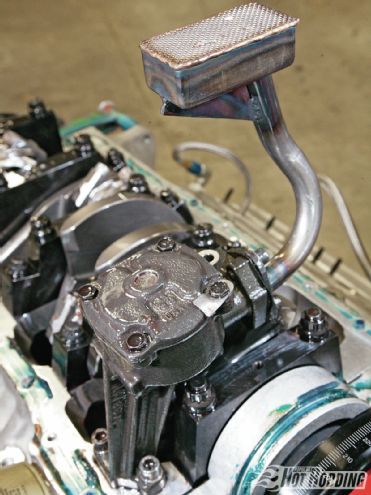 A reliable Melling oil pump moves the AMSOIL 0-20 viscosity motor oil through the lubrication system, ensuring the internal parts operate reliably at high power and high rpm. A custom Stef’s fabricated aluminum oil pan holds the oil.
A reliable Melling oil pump moves the AMSOIL 0-20 viscosity motor oil through the lubrication system, ensuring the internal parts operate reliably at high power and high rpm. A custom Stef’s fabricated aluminum oil pan holds the oil.
Up top, Trefz originally built the engine with a custom sheetmetal intake manifold, however the AMSOIL Engine Masters Challenge competition requires a cast intake manifold. To fulfill this requirement, an Edelbrock Yates single-plane was substituted. Trefz tells us, “I had to make a last-minute change to the cast manifold to meet the event rules, and it definitely showed a loss of power. The intake swap cost us about 100 hp in testing, so that was disappointing. With more development time on the manifold, the question is just how many of those horsepower we could have gained back. I literally got the manifold bolted on and tested the day before leaving for the event, and was disappointed by the power loss, but loaded up and went to the competition.” The crew at LTR did have some time to mildly modify the intake, reducing the cross-sectional area with epoxy filler added to the floor to improve velocity, and mildly massaging the plenum area. An open adapter spacer mates the intake’s 4150 flange with a BRE-modified Holley 1150 Dominator carb.
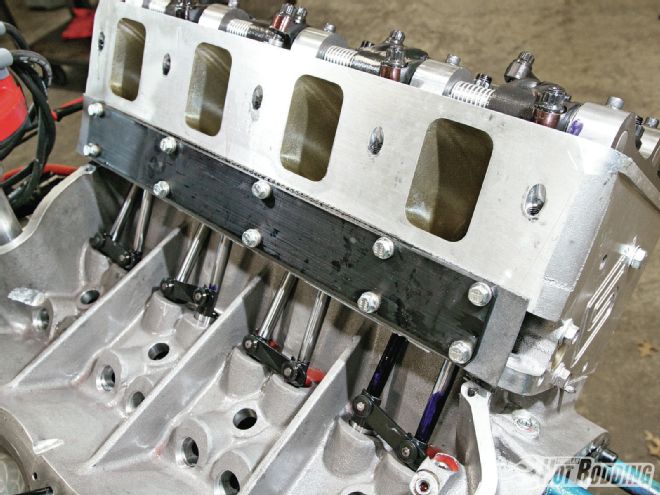 With a cylinder head mounted to the block, the scale of the Arias/Shelby conversion heads come into context. The ports are raised significantly above the deck, giving the large runners an advantageous angle of approach into the cylinder. Intake port flow for the CNC-ported Arias/Shelby heads tops 409 cfm, while the exhaust flows 301 cfm.
With a cylinder head mounted to the block, the scale of the Arias/Shelby conversion heads come into context. The ports are raised significantly above the deck, giving the large runners an advantageous angle of approach into the cylinder. Intake port flow for the CNC-ported Arias/Shelby heads tops 409 cfm, while the exhaust flows 301 cfm.
Rounding out the engine combination, a CRS electric water pump circulates the coolant without paying a tariff in power, while an ATI Superdamper is mounted to the nose of the crank just below to keep crank harmonics in check. Ignition is provided by all MSD components, centering on a deadly accurate MSD crank trigger signaling an MSD Digital 7 ignition, with the HVC II coil, ProBillet distributor, and wires all also from MSD. Handling the exhaust are stainless steel headers from SPD, using 2-inch primary tubes and a tri-Y–style collector. The bottom end is sealed by a custom full-length Stef’s oil pan holding just 7 quarts of AMSOIL 0-20 synthetic motor oil. As Trefz tells us, “I decided that a big deep oil pan would keep the oil away from the crank and had the idea of using a big, deep, full-length pan. I called Stef’s to have it built, thinking I was onto something, and as soon as I began explaining what I wanted, they said they had already built a dozen pans just like that for the Engine Masters Challenge.”
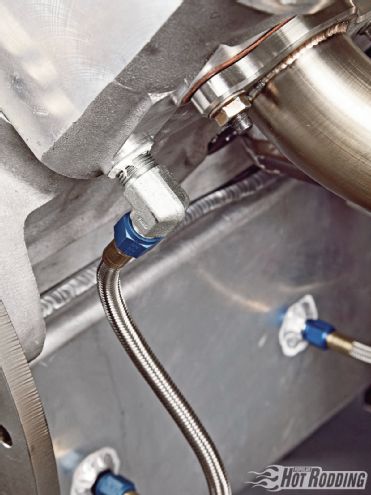 Oil drain back from the top end is assisted by a pair of drain provisions in the cylinder heads, with external lines routing oil from the heads directly back to the pan.
Oil drain back from the top end is assisted by a pair of drain provisions in the cylinder heads, with external lines routing oil from the heads directly back to the pan.
The engine certainly garnered the attention of everyone in attendance at the 2011 AMSOIL Engine Masters Challenge on looks alone. The Arias/Shelby conversion heads and aluminum Shelby block gave the engine a captivating exotic look that emphasized the engine’s performance potential. Despite outright peak power that was well down on the more developed combination using the custom sheetmetal intake manifold, the 427-cube Shelby effortlessly ran through the rigors of the Challenge, while delivering a peak output of 748 hp. That’s exotic output for any naturally breathing 427-cube engine.
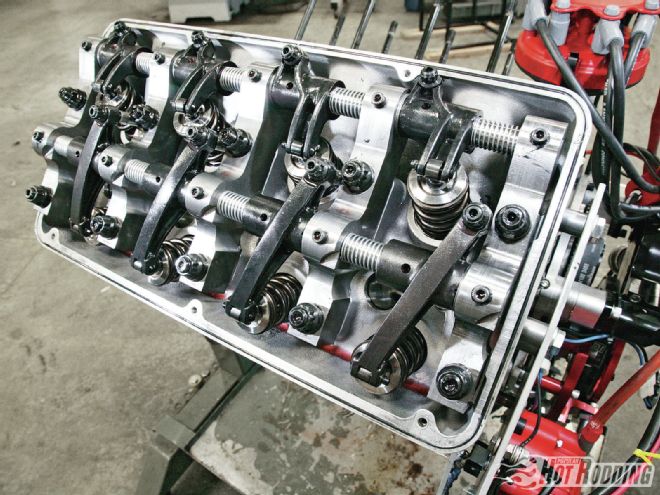 The Arias rocker arrangement is a work of art, with bulletproof investment-cast 4340 steel shaft-mounted rockers. These rockers ride on the shafts supported by dual gangs of roller bearings, and feature H-13 tool steel adjusters, while oiling is provided through the pushrods.
The Arias rocker arrangement is a work of art, with bulletproof investment-cast 4340 steel shaft-mounted rockers. These rockers ride on the shafts supported by dual gangs of roller bearings, and feature H-13 tool steel adjusters, while oiling is provided through the pushrods.
“You can make a great street engine from a race engine, but you can’t make a great race engine from a street engine.” —Nick Arias Jr.
“Capping the cylinders is the crowning jewel of the combination, the Arias/Shelby cylinder heads.”
“The valve angles allow for a much smaller chamber volume than older Hemi designs…”
By The Numbers
427ci Windsor Ford
Arias Hemispherical Head Conversion
Bore:
4.125 inches
Stroke:
4.00 inches
Displacement:
427 ci
Compression ratio:
14.4:1
Camshaft:
Contreras solid roller
Camshaft duration:
268 degrees at .050-inch tappet rise
Valve lift:
.810 inch
Rocker ratio:
Arias rockers; 1.82/1.75:1 ratio
Piston rings:
Total Seal
Piston:
Arias
Block:
Shelby Aluminum Windsor
Crankshaft:
Scat
Rods:
Carrillo
Cylinder head:
Arias Windsor Hemispherical
Intake valve diameter:
2.250 inches
Exhaust valve diameter:
1.600 inches
Intake manifold
Edelbrock
Carburetor:
Holley 1,150-cfm Dominator
Header:
SPD 2-inch primary
Ignition:
MSD Digital 7 and crank trigger
Damper:
ATI
Fuel:
VP Q16
RPM TQ HP 3,500 445.3 296.7 3,700 485.7 342.2 3,900 509.8 378.5 4,100 529.2 413.1 4,300 540.7 442.7 4,500 543.1 465.3 4,700 550.0 492.1 4,900 567.6 529.6 5,100 584.4 567.4 5,300 598.6 604.0 5,500 606.7 635.4 5,700 609.1 661.1 5,900 608.3 683.3 6,100 605.7 703.5 6,300 601.9 722.0 6,500 593.6 734.7 6,700 584.3 745.4 6,900 569.3 747.9 7,100 551.5 745.6 7,300 532.1 739.5 7,500 516.4 737.4
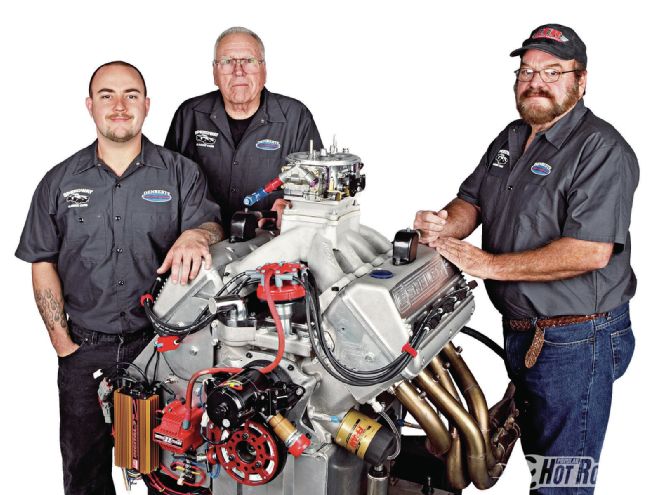 With nearly 750 normally aspirated horsepower from their 427-cube Arias/Shelby combination, LTR’s team (from left to right) of Joe Felciano, John Garrison, and team leader Lanny Trefz are justifiably proud of their first effort at the Engine Masters Challenge competition.
With nearly 750 normally aspirated horsepower from their 427-cube Arias/Shelby combination, LTR’s team (from left to right) of Joe Felciano, John Garrison, and team leader Lanny Trefz are justifiably proud of their first effort at the Engine Masters Challenge competition.